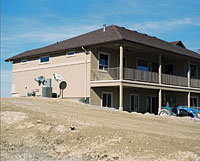
While it would certainly be remarkable if builders gave all homeowners the option to upgrade the HVAC systems in their new homes, it's even more extraordinary when they offer high-end equipment in spec homes. But that's what one new homebuilder in Colorado recently did. Granted, it's a custom home, but the builders, Dorssey Custom Homes and Fisher Construction, felt strongly about providing the best quality heating and cooling system for whomever ended up buying the high-end home.
Toby Monger, owner, Monarch HVAC, Grand Junction, Colo., had worked with the builder before and was more than happy to accommodate the request for a high-efficiency heating and cooling system. Monger primarily works in the new construction market, and he is happy to see builders becoming more interested in better equipment. "It's been a long road trying to get builders to think high efficiency, but more homeowners are thinking about it, so more builders are thinking about it," he noted.
Different Ideas Of Zoning
The custom home, which was finished in August, consists of 3,000 sq ft on the main floor and an unfinished 3,000-sq-ft walkout basement. A large bonus room is located over the garage. Because of the wide range of current and future living spaces, the builder felt strongly that the house must be zoned.
Fortunately for Monger, the first mechanical contractor consulted for the job thought that zoning meant installing numerous furnaces throughout the home. The builder didn't think that sounded quite right, so he contacted Monger, who believed that one furnace, one heat pump, and three zones could keep the home comfortable. He suggested that a separate ductless mini-split system be installed to heat and cool the bonus room.

"We configured the system so that the heat pump is used until the outside temperature drops to 30 degrees F. We set up the controller so that when the temperature gets below that point, it automatically kicks over to the gas furnace. The heat pump is sufficient to heat the entire home until then," said Monger.
Carrier's Infinity Zone Control system was installed, which includes five zone dampers for the three different zones. One zone consists of the master bedroom area, which is located on one side of the house, the second zone takes care of the two spare bedrooms and the large living area located on the other side of the house, and the third zone is for the future basement.
A Carrier ductless mini-split system was installed in the bonus room, while an electronic air cleaner and a large fan-powered humidifier rounded out the HVAC system in the main house. The total cost of the HVAC system came to $19,850.

"The nice part was that we had plenty of room in which to work, because the basement was wide open."
Monger noted that he was "borderline" on the size of the furnace and, indeed, the total system for the house. "If the house would've been any bigger, we would've needed a second furnace. However, the builders upgraded the insulation, the wall thickness, the windows, and everything else to make sure we could do this with one system."
The house sold after it was roughed in, and Monger was able to meet the homeowner and show her how to operate and maintain her new heating and cooling systems. In addition to walking her through the system, Monger took the opportunity to discuss the benefits of UV lights and a heat recovery system with the homeowner, and she's considering installing those options as well.

Growing Trend
While it may seem more likely for a custom home builder to specify higher-efficiency heating and cooling equipment, tract home builders are also getting onboard. Monger thinks it's due to customer demand. "One of my tract home builders is only specifying 90 percent efficiency furnaces now, because they're trying to build a home that is more appealing to the homeowner. With gas prices rising the way they have been, people are thinking of how this relates to gas use in their homes."This particular tract homebuilder specifies 90 percent single-speed, single-stage furnaces as the starting point, then homeowners can upgrade the equipment if they'd like. "Just recently, Carrier put together a Web site through which builders can more easily sell upgrades to their customers," noted Monger. "That's going to be a big help."
Unfortunately, there are still builders who do not want contractors talking to their customers until the house is finished. Monger said he gets frustrated with these builders, because he'd like to present the various HVAC options to the homeowner before the equipment is installed. In these cases, he says he sends out a letter to every address after it's occupied, offering to give the homeowners a tour of their heating and cooling system.
"This allows us to show them how to operate their programmable thermostats, change their filters, etc. It also gives us the opportunity to talk up the benefits of a humidifier or an electronic air cleaner," said Monger. "I've even had homeowners change out their furnace from an 80 percent to a 90 percent. We do our best to try to get through to the homeowner about the importance of efficiency."
Builders are also catching on to the importance of efficiency, and as a result, many are choosing to specify more efficient heating and cooling systems in their new homes. That's good news for contractors, and it's also good news for homeowners, who can save some money and be more comfortable with their upgraded heating and cooling systems.
Publication date: 11/21/2005





